The prevalence of acne during puberty reaches almost 100% in both boys and girls equally, but in a later period (after 20 years and even 40) the disease is more typical for women. Just like in youth, acne appears on the forehead, chin and cheeks. The factors influencing their education are numerous. Equally, if acne appears on the forehead, the causes in women may be related to genetics, health conditions and environmental factors.
Why do pimples appear on the forehead?
In order for acne to appear on the forehead, several factors must work at once:
The cells of the stratum corneum of the gland ducts thicken, grow, and begin to exfoliate intensively. As a result, a plug of sebum and desquamated scales is formed - a comedon (open or closed). According to one version, this process is activated by a lack of linoleic acid, an increased level of male sex hormones and an increase in the enzyme that converts testosterone into a more active form, dehydrotestosterone, which enhances the production of sebum and cell proliferation.
- Increased sebum secretion
Against the background of hyperkeratosis and the formation of plugs, the production of sebum provides favorable conditions for acne bacteria, since the fats in sebum (sebum) provide a breeding ground for them. Bacteria join the comedone that has clogged the sebaceous gland duct, and a critical moment comes when the pressure ruptures the duct and an inflammatory process occurs.
These are gram-positive bacteria. They contain an antigen that the body recognizes and begins to produce antibodies to it, which ends in inflammation.
Inflammation is not only a consequence of the appearance of comedones and a reaction to enzymes produced by bacteria. It itself can precede their appearance and participate in the development of acne.
Provoking factors
When acne is constantly found on the forehead, the reasons for its appearance in women can be associated with many factors:
- Blockage of the sebaceous gland duct by dead skin cells, cosmetics, dust or dirt with concomitant hypersecretion of sebum.
- Various infectious processes, including parasitic etiology.
- Hormonal disorders (increased production of androgens, malfunction of the thyroid gland). Also common causes of acne in women are changes in the body during pregnancy and puberty.
- Disruptions in the normal functioning of the gastrointestinal tract. Most often, rashes on the forehead occur due to dysfunction of the intestines, stomach and liver.
- Unbalanced diet (excess of simple carbohydrates, fried, fatty foods in the diet, frequent abuse of fast food) and bad habits.
- Taking various medications, including oral contraception, self-treatment with antibiotics and prescribing vitamin complexes.
- Allergic reactions to cosmetics, medications, care products, food, insufficient removal of cosmetics before bed. Abuse of harsh facial scrubs and acid peels.
- Constant skin irritation from hats, hairbands, and touching the skin with dirty hands.
- Attempts to squeeze out pimples on your own and, as a result, the infection spreads even deeper and further.
- Negative impact of the external environment (ecology, work conditions).
- Decreased immunity, metabolic disorders associated with stressful situations, long-term depressive states.
Thus, for each specific patient, the solution to the problem of acne on the forehead is selected individually - depending on the state of health, lifestyle, eating habits and hormonal levels.
Types of acne on the upper face
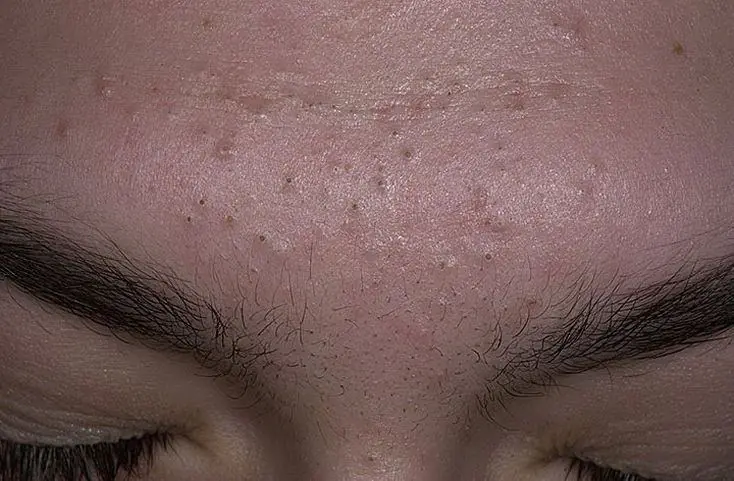
Pimples on the forehead are of the following types:
They can be with purulent heads (noticeable, inflamed) and as closed comedones (non-inflamed, white, dry), felt only with tactile contact and in bright light. They are located in the upper layer of the epidermis, quite close to the surface of the skin. They give the face an extremely unkempt appearance, but are the easiest to treat, disappearing without traces (provided they are removed correctly).
- Deep, painful subcutaneous pimples on the forehead
The process of their maturation is very long, accompanied by itching, pain, redness of the skin, and the sensation of a dense cyst-like formation when palpating the skin. They cannot be removed until they reach the last stage of development with the formation of a large purulent head.
The last type of acne is the most aesthetically unpleasant and difficult to treat. Self-medication in this case is strictly prohibited.
Measures to eliminate acne
The causes and treatment of acne in the forehead area are closely interrelated, so very often not only the help of a dermatologist is required, but also consultation with a gynecologist, endocrinologist, gastroenterologist, allergist-immunologist.
Only specialists will be able to correctly diagnose, establish the causes and prescribe adequate treatment by prescribing an individual list of drugs in suitable doses and the required concentration. It is not recommended to independently find out the causes of acne, much less determine therapy.
To successfully get rid of acne, you must adhere to the following rules and recommendations and follow them in combination:
Follow a diet with a minimum amount of fatty, spicy, sweet foods, and at the very beginning of treatment, eliminate them altogether. For normal functioning of the gastrointestinal tract, consume foods high in fiber and drink at least 1.5-2 liters of clean water per day. Avoid constipation to avoid slagging and intoxication of the body.
- Provide proper cosmetic care
Do not overdry your skin with alcohol-based cosmetics. Excessive cleanliness can lead to the opposite results - excessive dryness is perceived by the sebaceous glands as a danger to the skin, and they begin to produce more sebum and provoke new rashes. It is also not recommended to use soap, scrubs and irritants for washing. You should use products that do not change the pH balance of the skin.
Proper cleansing of the skin contributes to a more effective effect of medications. In summer, you should definitely apply sunscreen.
After washing, use disposable paper towels instead of regular terry towels, as the latter creates an ideally moist environment for bacteria to multiply. Change pillowcases on your pillow more often, wash hats.
- Follow the course of therapy prescribed by your doctor
If the reason why acne appears on the forehead is associated with a hormonal imbalance, treatment is often carried out with combined oral contraceptives with sufficient doses of synthetic estrogens (Diane 35) or drugs with a strong antiandrogenic effect (Cyproterone). For women who have not responded to other treatments, hormone therapy can be very effective. Oral contraceptives are considered the most preferred due to the low incidence of side effects.
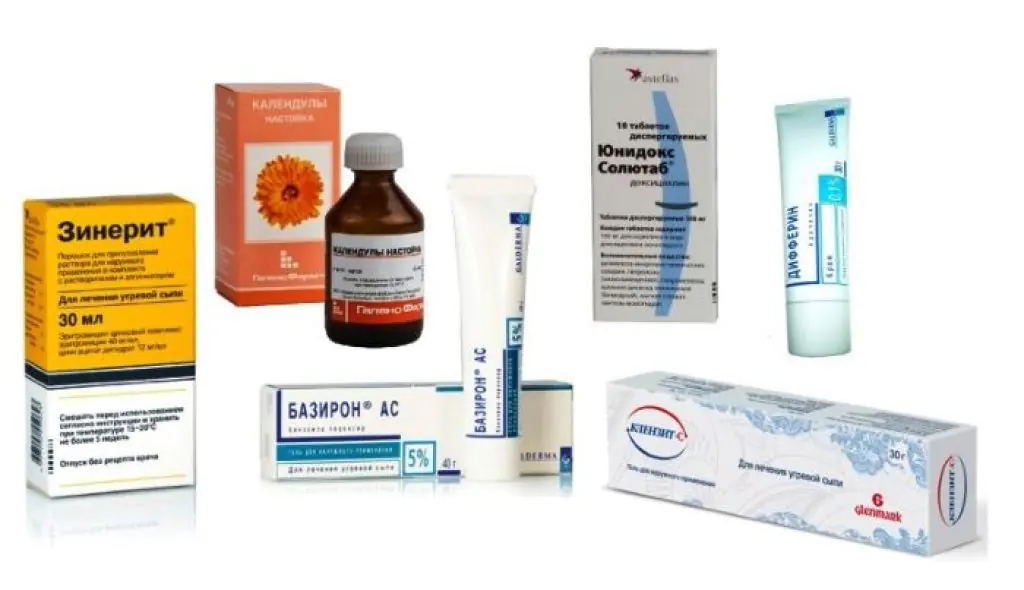
Among local remedies, preparations based on salicylic acid (sold without a prescription) and azelaic acid are widely used. Not only do they have antibacterial properties, but they also prevent the appearance of pigmented spots that often leave behind pus-filled acne. Such drugs as Baziron AS and Proderm based on benzoyl peroxide are widely prescribed. The advantage of these drugs is that bacteria do not develop resistance to the main substance and therefore its effectiveness does not decrease. Together with benzoyl peroxide, it is possible to prescribe local antibiotics and, above all, Clindamycin.
Local remedies are prescribed drugs based on synthetic retinoids, for example, Differin, but also in combination with benzoyl peroxide. In this case, retinoids are applied to the affected area for no more than 5 minutes and washed off with water. With longer contact they can cause dermatitis. Retinoids are not prescribed to women during pregnancy and breastfeeding.
Pimples on the forehead, especially subcutaneous ones, can also be treated with systemic antibiotics such as Doxycycline, Clindamycin, Dapsone, etc.
The list of all drugs successfully used in the treatment of acne is huge, but most of them have an equally impressive list of side effects, which is why it is so important to know the exact reasons why acne appears on the forehead and only then prescribe treatment.
Elimination of post-acne is one of the points of complex therapy. Now medicine and cosmetology offer a wide range of physiotherapy procedures to eliminate skin defects. Particularly popular are methods of using a laser beam. Dermabrasion and peeling are also used, so complications such as scarring and blemishes can be kept to a minimum.
Preventing acne on the forehead
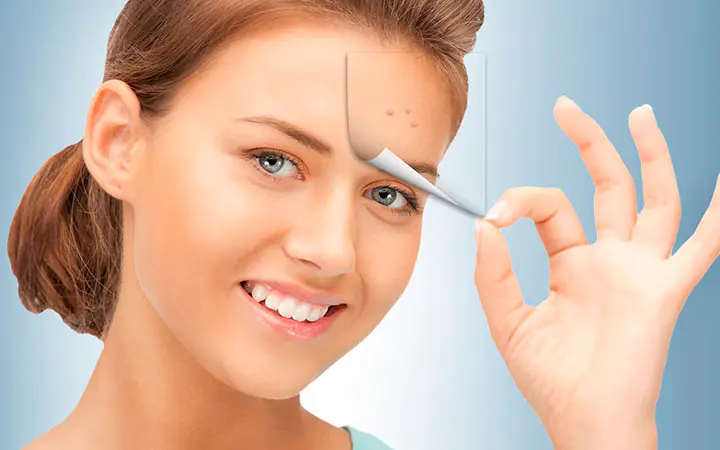
To ensure that acne on the forehead no longer bothers you, you need to make the remission period as long as possible. To do this, you should follow simple recommendations:
- Select cosmetics based on your skin type, with no comedogenic ingredients (talc, silicones, mineral oils). Avoid products that are overly aggressive and dry the skin. Remove makeup carefully.
- Do not touch your skin with dirty hands, do not rub it, and do not lean your face against contaminated surfaces.
- Do not squeeze pimples, as there is a risk of worsening the situation.
- Eat right, stop going on strict diets, drink a lot of clean water.
- Avoid strong hormonal fluctuations in the body (be less nervous, avoid uncontrolled use of oral contraceptives).
- Spend more time in the fresh air, be quite physically active, since playing sports triggers metabolic processes in the body, improves blood microcirculation, preventing stagnation.
- Avoid foods and substances that cause hypersensitivity reactions in the body.
- Take balanced vitamin complexes.
The problem of acne on the forehead can be solved provided that you contact a specialist in a timely manner, prescribe correct pathogenetic and symptomatic therapy, and strictly adhere to the prescribed regimen.
The appearance of acne on the forehead in women may have non-serious causes, or may signal the presence of a pathological process in the body. There are plenty of treatment methods for rashes. However, none of them will bring results if you do not identify the internal organ, the problems with which caused the skin blemishes.
Types of acne on the forehead
Inflammatory processes are the main causes of rashes on the forehead. The skin becomes covered with tubercles containing purulent contents. Problem areas hurt when pressed.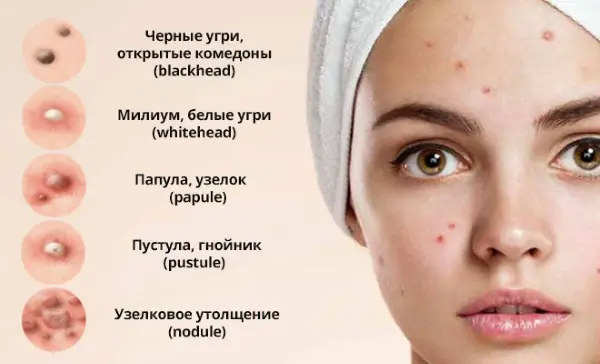
This group includes:
- Nodules: size 10-30 mm, purple, red or bluish in color. They are formed due to damage to the follicle and the penetration of its contents into the deep subcutaneous layers. The skin on the forehead at the location of the pimples, after they are removed, may become covered with scars or dark spots.
- Papule: small redness ranging from 1 to 10 mm, pink or red. At the site of such inflammation there are no scars or cicatrices during recovery.
- Cyst - purulent formation is dense to the touch. Multiple cysts are often combined into a single chain and are connected by narrow channels running deep in the tissues. After their treatment, traces of presence remain on the skin in the form of dimples, scars, scars.
- Pustule - a pimple filled with pus with a white head. They form from papules or independently.
- Comedones - skin formations of a non-inflammatory nature. They look like small bumps on the surface of the skin, white in color, making it rough. Appear in the upper layers of the skin.
- Black dots They look like ordinary dirt. The reason for the formation is the oxidation of the sebaceous glands during a reaction with oxygen. The color of the rash ranges from brown to black.
Is it possible to squeeze out
The human immune system, protecting itself from the spread of infection throughout the body, blocks the source of inflammation, protecting it from healthy tissues. The site of infection is additionally saturated with immune cells, thus supplying white blood cells to the affected area. Subcutaneous pus consists of dead leukocytes and microbes.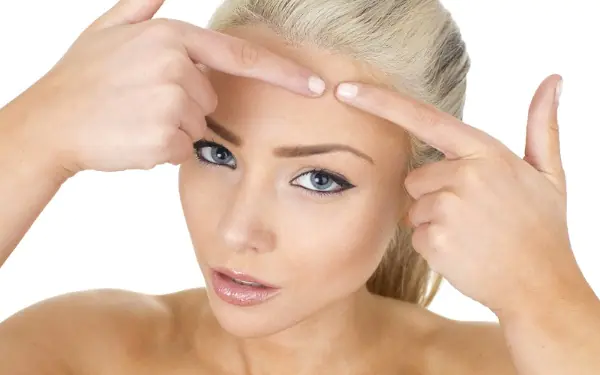
Anyone who squeezes a pimple wants to get rid of the purulent contents. If you remove the source of inflammation, the skin will heal faster, but another scenario is also possible.
Possible complications:
- sepsis - blood poisoning;
- blood clot separation - the plug formed at the site of removal of pus may come off;
- infection - extrusion increases the risk of formation of 5 similar ones in its place and nearby;
- skin trauma - consequences in the form of scars, cicatrices, skin pigmentation and dimples.
Causes of acne
Causes acting from outside
Pimples on the forehead require special care, since their causes in women often lie in increased fat content. Large amounts of sweat and sebum have a beneficial effect on the development of pathogenic flora, bacteria and viruses. Hence, inflammation in the forehead area is more frequent.
Main reasons:
- Improper care, use of cosmetic products with a composition that does not match your skin type, heavy makeup, poor cleansing clogs the pores. As a result, microbes develop in it, causing acne to grow.
- The causes of acne in the cold season lie in the regular wearing of a hat made of synthetic material.
- Overheating or hypothermia can cause problems. Wearing bangs or a bandage covering the forehead area can cause inflammation.
- Subcutaneous mite - demodex. The parasite multiplies in 3-4 days. My favorite area to live on the face is the forehead.
Internal reasons
The reasons for the appearance of acne on the forehead, hidden inside the body, include:
- An allergic reaction of the body to an irritant entering the gastrointestinal tract. The rash in this case has a pale pink color without pus inside. Problem areas often itch and peel. The most common allergens: chocolate, bee products, eggs, cocoa, coloring pigments, chemical additives, harmful and poisonous products.
- Emotional turmoil and stress. Skin problems of this nature usually occur in women aged 30 to 45 years. Pimples have different shapes and sizes, form in groups, do not cause pain, and are pink in color.
- Diseases of internal organs: Gastrointestinal tract (gastritis and pancreatitis), endocrine system disorders (diabetes, hypothyroidism), diseases of the female organs with changes in hormonal levels, diseases that impair the conductivity of the arteries.
Which organ is wrong?
The appearance of acne on the forehead may be associated with digestive problems:
- The appearance of a pimple rash on the face near the eyebrows indicates problems with the small intestine, and at the beginning of the hairline it signals diseases of the colon. The organs are not able to cope with the release of toxic substances from the body. Then the skin comes to their aid, trying to release toxins through the pores. The reasons lie in poor nutrition, dysbiosis, and overeating.

Diseases of the internal organs can cause acne to appear on the forehead and other areas of a woman’s face.
Why do they appear during pregnancy?
The occurrence of skin problems in the forehead area in pregnant women indicates the beginning of changes in the body. An increase in the hormone progesterone explains the main reason for the appearance of acne in expectant mothers. It is he who helps to cover the face with such formations. Its level rises rapidly in the first trimester and this explains the appearance of the rash in the early stages.
There are a number of other reasons:
- Lack of fluid in the body. A state of water fasting allows you to increase the concentration of hormones in the blood and provokes an increase in sebum secretion.
- Nervous shocks.
- Power failures.
- Cosmetics that are not suitable for your skin type.
- Insufficient hygiene.
Treatment with medications
It is possible to get rid of the problem if the cause of its occurrence and the factors that provoked inflammatory processes in the skin are clear:
- Stress acne requires medical treatment and regulation of stress factors. Drugs that correct a person’s psycho-emotional background: Tenoten, Afobazol, Persen.

- Slagging of the intestines and the circulation of substances that poison the skin are eliminated by bacteria-containing products: Bifidum, Normobak, Narine, Yogulakt.
- If the cause is pathogenic flora, it is recommended to take drugs with antibacterial and anti-inflammatory effects: Klenzit-S, Salicylic acid, Zinerit, Baziron.
- Purulent rashes will be eliminated by Levomikol or Erythromycin ointment. They are suitable for the treatment of teenage skin problems, often accompanied by the appearance of festering, large acne.
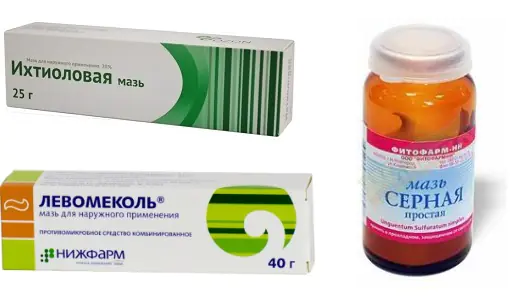
- Sulfur ointment is suitable for subcutaneous acne. Its main component has an antimicrobial and drying effect, reduces the production of subcutaneous fat.
- Ichthyol ointment applied to a purulent formation stimulates its maturation.
Antibiotics
Pimples on the forehead (causes in women can provoke damage to other parts of the body - shoulders, chest and back) are treated with antibiotics.
The following medications are common against acne:
- Erythromycin - a macrolide that has an antimicrobial effect on the skin. Statistics show that its effectiveness is 30% in treating this disease. It has a comprehensive effect on acne by destroying microbes that cause the development of rashes.
- Clindamycin - an antibiotic of the lincosamide group. It is similar in action and effectiveness to erythromycin.
- Clynesfar - consists of tretinoin and erythromycin. Effective against streptococci and staphylococci. Actively kills bacteria and microbes and blocks their reproduction.
- Unidox Solutab - a new generation antibiotic, very powerful. In parallel with it, it is necessary to consume bifidobacteria.
- Vilprafen - a killer weapon in the fight against rashes. Approved for use from 14 years of age.
External means
Ointments for rashes are prescribed in the presence of single or multiple open or closed acne:
- Zenerite — the drug has regenerating properties and antimicrobial effects. The components that make up the product and have a therapeutic effect are zinc acetate and erythromycin. They inhibit the activity of the sebaceous glands and act bacteriostatically. The product is applied to clean skin; cosmetics must first be washed off. Apply twice a day: morning and evening. The treatment period lasts from 10 to 12 weeks.

- Skinoren — the active component of the drug is azelaic acid. It is able to reduce the density of bacterial colonization that causes acne in all layers of the skin. The gel reduces the content of fatty acids in the epidermis and normalizes metabolic processes. The product is non-toxic and can be used externally on large areas of the skin. The skin is prepared for treatment by cleansing with running water and blotting with a towel. The drug is applied in a thin layer to problem areas, lightly rubbing. The duration of treatment is from 1 month to a year. The application regimen is prescribed by a dermatologist.
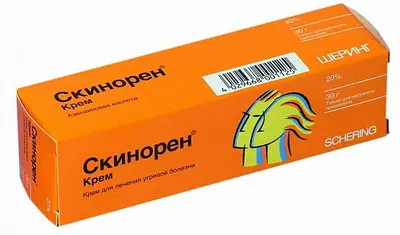
- Cynovitis (cream-gel) for acne. Components of the drug: licorice root, zinc, panthenol, lactic acid, shea butter, jojoba and olive. The product eliminates skin inflammation, irritation, and peeling. Regenerates cells, nourishes and has a moisturizing effect. Cleanses the skin and removes dead skin particles. The gel is applied pointwise and rubbed into problem areas. The procedure is repeated in the morning and evening until the acne completely disappears. After improvement occurs, treatment is continued for a week.
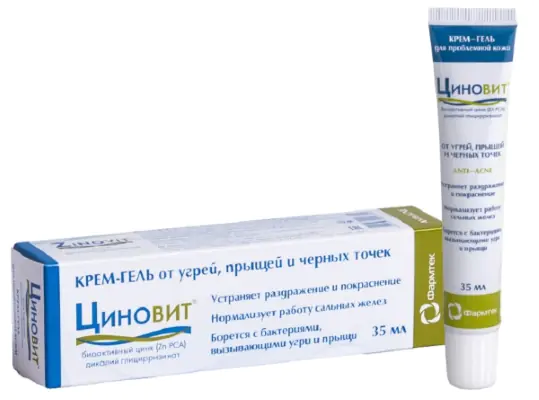
- Ichthyol ointment. Its main constituent substance is obtained from oil shale, thanks to which the product is saturated with vitamins and microelements. Treatment with medication is carried out on purulent acne, which can first be pierced with a treated needle. Then stick a patch soaked in ichthyol ointment to the inflamed area. Leave the application for 3 - 4 hours.
Vitamin and mineral complexes for acne
Vitamin intake is agreed with the treating dermatologist. They drink complex drugs containing all the necessary elements and narrow-acting drugs.
These are the following drugs:
- Aevit — vitamin A and E. A food supplement will relieve acne and heal wounds, improve metabolism, and regulate fluid content in the skin. It can be used not only internally, but also externally. To do this, the capsule with its contents is pierced and the oily substance is applied to the rash.
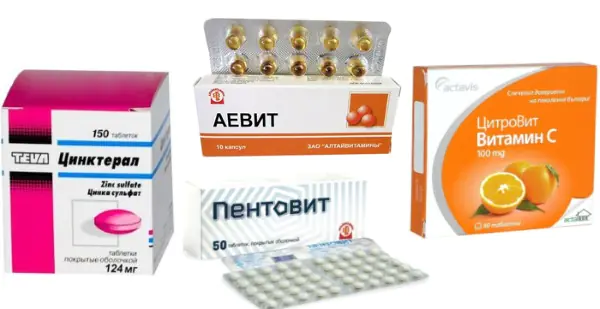
- Zincteral or Zinkovital - supplements with zinc. They normalize the functioning of the glands, remove toxins and cleanse the skin.
- Pentovit — B vitamins. Improve the appearance of the epidermis, hair and nails.
- Citravit - complex with ascorbic acid. Rejuvenates, makes the skin elastic, and protects against exposure to ultraviolet rays.
Cosmetological treatment methods
The procedures that are offered today in beauty salons are not much inferior in variety, depth of impact and effectiveness to medicinal methods.
A high-quality, timely consultation with a cosmetologist will help you choose the optimal treatment option, thanks to which you can eliminate acne for a long time.
List of procedures:
- Cleaning the skin. The procedure allows you to remove external manifestations, however, it does not destroy the cause. Therefore, it is used in complex treatment to eliminate internal factors for the appearance of a rash. Skin cleansing is carried out with ultrasound and high-frequency current. In the first option, dead layers of the epidermis are removed, pores are cleaned, and microcirculation in the vessels increases. Exposure to current helps relieve inflammation, destroy infection and smooth out scars.

- Laser peeling — burning out the top layer of skin with a laser. The procedure is painful and requires long rehabilitation, but the effect lasts for 2-3 years. Benefits: eliminates acne and sebaceous plugs, tightens pores, enhances the production of elastin and collagen.

- Mesotherapy - injection of medications into areas of the skin covered with acne. Treatment involves the simultaneous use of antibiotics and antibacterial agents. Effective for suppuration and wen.
- Biodermabrasion - a combination of peeling based on chemical compounds and dermabrasion. First, the skin is coated with substances that include acids, vitamins and microelements, and then polished with diamond peeling. The results of the drugs are visible after the procedure is completed. It does not injure the skin, cleanses it, rejuvenates it and eliminates pigmentation.
Cleansing and steam baths
The procedure, which every woman can perform at home, perfectly cleanses the face and saturates dry skin with water and oxygen. Steam enriched with water softens the stratum corneum and makes it easier to remove, increases blood circulation, and activates glands and pores. Due to this, toxins and dirt accumulated in the lower layers of the epidermis are removed.
Tips for increasing the effectiveness of steam baths:
- If you add bay leaf to boiling water, it will increase circulation in the vessels.
- Licorice herb will remove toxins.
- Essential oils activate the brain. They have a relaxing effect on the body as a whole.
- A handful of celandine or burdock added to the container for the procedure will open the pores and disinfect.
- For those with dry skin, it is better to inhale with chamomile, and for oily skin with calendula.
The duration of the procedure should not exceed 25-30 minutes.
Folk remedies
The mask recipes presented below can, with constant use, eliminate rashes on the forehead
Blue clay mask
Reduces the visibility of rashes, and 3-4 applications will eliminate them completely.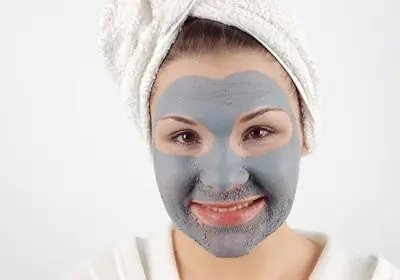
You will need:
- blue clay;
- 1 tsp lemon juice;
- 1 tsp alcohol tincture of calendula purchased at a pharmacy.
How to use:
- All ingredients are mixed until a paste is obtained.
- After the applied solution has dried, leave it on the face for 15 minutes.
- Removal from the skin is carried out by rinsing with warm water.
Protein mask
Dries out acne and heals wounds.
Ingredients for its preparation:
- vodka - 1 tbsp;
- iodine - 5 drops;
- egg white - 1 pc.;
- The white is beaten, iodine and vodka are added to it;
- The mask is applied in layers. Each subsequent one after the previous one has dried. 3 layers are enough;
- Leave for 20 minutes and rinse with cool water;
- I do the procedure 3 times a week. 5 masks are enough.
Aspirin with honey
Aspirin and honey can eliminate pimples on the forehead, influence the internal causes of their appearance in women, heal wounds, and smooth out dimples (pimples).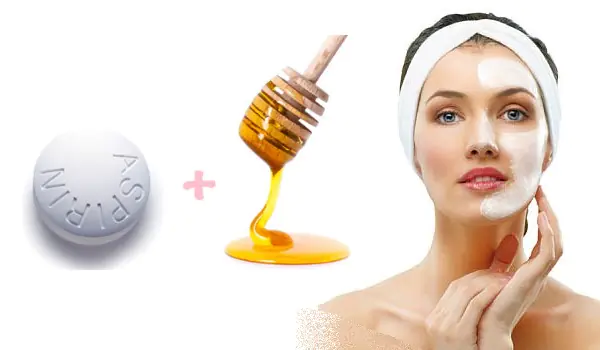
Sequencing:
- It is necessary to soften 2 aspirin tablets by dropping 2 drops of water on them;
- Mix the softened medicine with 1 tbsp. l honey and apply to the forehead or the entire face for 15 minutes;
- The mask is washed off with warm water, and the skin is first cleaned with wet wipes soaked in chamomile concentrate.
Methods for getting rid of purulent and inflamed acne
Women should not ignore the appearance of rashes on the face, since the causes can be different. The rash can spread to other areas of the face. For example, ulcers form on the forehead, nose, chin, and cheeks.
A neglected purulent pimple can develop into a boil, which can only be removed surgically.
The following will help prevent rashes and eliminate existing ones:
- Take foods containing vitamin A daily.
- Cosmetic procedures - masks, peeling, facial cleansing are also effective in combating skin defects.
- Those with problem skin should not forget to use special lotions, masks and creams.
- Drinking a glass of water every day on an empty stomach will help remove toxins from the body and saturate the epidermis with moisture.
- Rubbing with apple cider vinegar diluted in 1 tsp of water will dry out weeping inflammations.
- It is better to replace tea and coffee with juices, fruit drinks, and jelly.
Daily walks in the fresh air, proper sleep, taking vitamin and mineral complexes, and psycho-emotional peace will help prevent acne from appearing on the forehead and eliminate the internal causes of rashes in women.
Article format: Svetlana Ovsyanikova
Video on the topic: acne on the forehead in women, causes of acne, treatment
Causes of acne on the forehead in women:
Why do acne appear on the forehead, methods of treatment:

Each of us periodically encounters acne, which can occur on any area of the face, but more often they form on the forehead. Moreover, it is in this area that it is most difficult to get rid of acne, so after they appear, you have to immediately begin serious skin treatment. Moreover, rashes on the face do not make the fairer sex beautiful.
What is acne?
Acne - skin defect, which occurs due to inflammation of the sebaceous glands and hair follicles. As a rule, they pop up on the chest, face and back.
With increased secretion production from the sebaceous glands and improper hygiene, the mouths of the hair follicles become clogged, which leads to the accumulation of sebum. If you press hard on this formation, a skin secretion will come out.
When the sebaceous gland is clogged, bacteria that live on the skin receive the best environment for proliferation, thereby provoking the development of inflammation. When acne breaks out, the infection and sebum come out.
Types of acne on the forehead
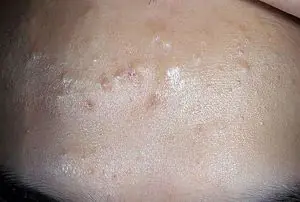
The following types of acne form on this area of the face:
- Closed. These include cysts, comedones (small rashes), subcutaneous papules that look like small red bumps or lumps.
- Open. Such pimples are considered to be purulent nodules, blackheads and huge acne.
Moreover, the emergence of all these formations due to certain factors, and in some situations even several.
Causes of acne on the forehead
As you know, the skin on the face is very thin, therefore it is too sensitive to various adverse effects. By the way, the forehead area is where most acne appears in the summer. This is due to high temperatures, since on a hot day the face sweats a lot, adding dirt and dust, as a result the skin becomes inflamed.
Hormonal disbalance
This reason is considered the most common cause of acne in girls. Its instability is caused mainly by the following factors: pregnancy, puberty and menopause. Hormonal levels can fluctuate due to pathological and inflammatory processes occurring in the female body. Therefore, if a lot of pimples appear on the forehead, then perhaps they indicate myometritis, cystic neoplasms, endometriosis, ovarian dysfunction and other diseases.
Skin type
The forehead is an area of the face that is characterized by enlarged pores and a huge accumulation of sebaceous glands. It is also called the T-zone. If the skin on the forehead is always oily, and it is not properly cleansed, then excellent conditions arise for clogging pores and the proliferation of bacteria, leading to inflammatory processes.
Poor nutrition
The cause of acne can be excessive consumption of smoked, fatty, canned, salty or sweet foods, as well as bad habits. By the way, alcoholic drinks and cigarettes are the main causes of loss of skin elasticity.
Medicines and cosmetics
The use of certain medications, especially antibiotics, often leads to the formation of acne, because they affect the motility of the gastrointestinal tract (GIT) if the rules of administration are violated. As a result, they become the cause of its dysfunction. Similar rashes can be associated with allergies, appearing against the background of side effects.
When a woman has any formations on her forehead, she tries to hide them under a layer of cosmetics using foundation. But the pores become even more clogged, creating favorable conditions for the rapid spread of bacteria.
Gastrointestinal diseases and endocrine disorders

Digestive problems are immediately reflected on the skin. That is why, if you notice acne on the T-zone, you need to check the functioning of your gallbladder, liver and intestines. In the latter case, the rash forms above the eyebrows, and in the first two cases, acne appears closer to the hairline.
Women often find acne on their face while taking hormonal medications or before menstruation.
In addition, rashes may appear if you constantly touch your face with dirty hands. Such a habit will, at best, lead to their formation, but at worst, it will provoke inflammation or even infection of the skin.
Preventive measures
To prevent acne on the forehead, you need to follow simple tips:
- regularly take care of your face, wipe it with decoctions of calendula or chamomile;
- adhere to the right lifestyle;
- observe drinking regime;
- choose and use cosmetics taking into account age and skin type;
- use scrubs at least once a week to exfoliate dead cells;
- don't forget about hygiene.
Effective methods to combat acne on the forehead
Never squeeze acne! All this will worsen the situation; on the contrary, there will be more of them, and your health can be seriously affected. It will take a long time to eliminate skin inflammations on the forehead, because in this area of the face there is an increased secretion of sebum. Before starting treatment, you must first find out the exact cause of their appearance by contacting a dermatologist.
After examination and tests he can write:
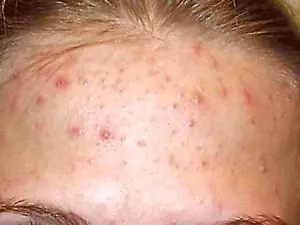
Antiprotozoal drug - Metronidazole;- Minerals and vitamins - zinc, A, C, B, E, copper, selenium and even brewer's yeast;
- Estrogen drugs are recommended for women who have a deficiency of sex hormones;
- For severe inflammation of the skin, antibacterial medications - “Erythromycin”, “Amiksin”, “Ciprofloxacin” or “Azithromycin”;
- Systemic retinoids, if pathological processes are difficult to treat - “Isotretinoin” and “Roaccutane”.
Of course, there are other medical medications that can help get rid of acne. For example, daily spot treatment of rashes with salicylic acid helps dry the skin and soften inflammation. You can also use products from it, since they also have anti-inflammatory and antibacterial effects.
An alcohol solution of chloramphenicol, which is used to wipe the affected areas, works well against acne. To fight bacteria and reduce inflammation, tar soap and ointments are used. More from formations on the forehead you can use mash, consisting of water, sulfur, camphor alcohol and lactic acid. In addition, doctors will tell you how to get rid of small rashes on the forehead with the help of cosmetic cleansing.
Cosmetic procedures for acne treatment
Today, hardware techniques help remove cosmetic defects on the face: peeling, vacuum and ultrasonic cleaning. The first method involves cleansing the skin using acids. With their help, the stratum corneum of the epidermis is exfoliated. Moreover, you can use the Darsonval apparatus yourself at home.
Vacuum cleaning involves disinfecting the skin with further pulling out blackheads and acne with a special device.
During ultrasonic cleaning, microvibration occurs, which opens the pores. This procedure is completely painless and effective, especially when combined with saturating the skin with nutrients.
Traditional recipes for treating acne
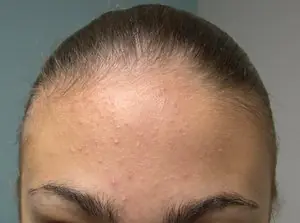
Women quite often resort to traditional medicine to get rid of hated acne on the forehead. Healers offer many different effective ways, let's look at the most popular of them.
A mask made from egg whites and oatmeal helps fight skin rashes. To prepare it you will need a few teaspoons of flakes and one egg white. The resulting mixture is applied to the forehead and other affected areas of the face and left for 15 minutes, after which it is washed off.
Chamomile infusion has antiseptic effects. Pour boiling water over the grass and leave for half an hour. After time, the decoction is filtered and then applied to the skin in the evening and in the morning. By the way, you can also make ice cubes from it. They perfectly tone inflamed areas.
Elimination of skin defects on the forehead with blue or green clay. Alcohol tincture of calendula, lemon juice and clay are used for this mask, everything is poured with boiled water and mixed well. It is applied to the face for about 15 minutes and washed off with warm water.
Also used to treat acne mixture of acetylsalicylic acid. It is prepared from 1 teaspoon of honey, 3 crushed aspirin tablets and warm water. The finished mixture is applied pointwise to the inflammation, and after 20 minutes it is removed.
But remember that you should consult your doctor before taking the above drugs and mixtures, because they may have various contraindications and side effects. Using high-quality cosmetics, maintaining hygiene and proper nutrition will help avoid the appearance of acne on the forehead.



